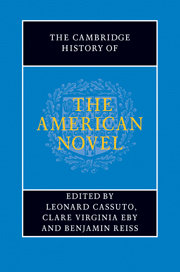Book contents
- Frontmatter
- General Introduction
- PART ONE INVENTING THE AMERICAN NOVEL
- PART TWO REALISM, PROTEST, ACCOMMODATION
- PART THREE MODERNISM AND BEYOND
- PART FOUR CONTEMPORARY FORMATIONS
- Introduction: contemporary formations
- 58 Postmodern novels
- 59 The nonfiction novel
- 60 Disability and the American novel
- 61 Model minorities and the minority model – the neoliberal novel
- 62 The American borderlands novel
- 63 The rise of the Asian American novel
- 64 Toni Morrison and the post-civil rights African American novel
- 65 Hemispheric American novels
- 66 The worlding of the American novel
- 67 The Native American Tradition
- 68 Contemporary ecofiction
- 69 Graphic novels
- 70 Twentieth- and twenty-first-century literary communities
- 71 A history of the future of narrative
- A selected bibliography
- Index
68 - Contemporary ecofiction
from PART FOUR - CONTEMPORARY FORMATIONS
Published online by Cambridge University Press: 28 July 2011
- Frontmatter
- General Introduction
- PART ONE INVENTING THE AMERICAN NOVEL
- PART TWO REALISM, PROTEST, ACCOMMODATION
- PART THREE MODERNISM AND BEYOND
- PART FOUR CONTEMPORARY FORMATIONS
- Introduction: contemporary formations
- 58 Postmodern novels
- 59 The nonfiction novel
- 60 Disability and the American novel
- 61 Model minorities and the minority model – the neoliberal novel
- 62 The American borderlands novel
- 63 The rise of the Asian American novel
- 64 Toni Morrison and the post-civil rights African American novel
- 65 Hemispheric American novels
- 66 The worlding of the American novel
- 67 The Native American Tradition
- 68 Contemporary ecofiction
- 69 Graphic novels
- 70 Twentieth- and twenty-first-century literary communities
- 71 A history of the future of narrative
- A selected bibliography
- Index
Summary
Ecofiction is an elastic term, capacious enough to accommodate a variety of fictional works that address the relationship between natural settings and the human communities that dwell within them. The term emerged soon after ecology took hold as a popular scientific paradigm and a broad cultural attitude in the 1960s and 1970s. Two key events helped spark this new environmental awareness: the controversy surrounding proposed dams on the Colorado River that led ultimately to the construction of the Glen Canyon Dam (begun in the mid-1950s and completed about ten years later), and the 1962 publication of Silent Spring, Rachel Carson's exposé of the environmental impact of toxic pesticides like DDT. Both generated widespread media coverage, bringing complex and urgent environmental issues and the ecological vocabularies that helped explain them into the American lexicon. Variations on these themes would thread their way through much writing about the environment for the next half-century. Before these controversies, few Americans thought about the unintended consequences of “progress” on the environment and its inhabitants. This innocence would be seriously challenged in the aftermath of Glen Canyon, Silent Spring, and the many environmental crises and controversies that followed.
The 1960s and 1970s also saw a growing awareness and acceptance of the new tools being used by scientists, journalists, and others to understand the natural world. Ecology, which had first emerged among naturalists in the late nineteenth century, became the default framework through which many people would view the natural world. Grounded in evolutionary theory, ecology came to stand for the biological framework that foregrounds the interrelations among plants, animals, soil and other landforms, and climate that constitute and sustain any natural community.
- Type
- Chapter
- Information
- The Cambridge History of the American Novel , pp. 1122 - 1136Publisher: Cambridge University PressPrint publication year: 2011
- 3
- Cited by



